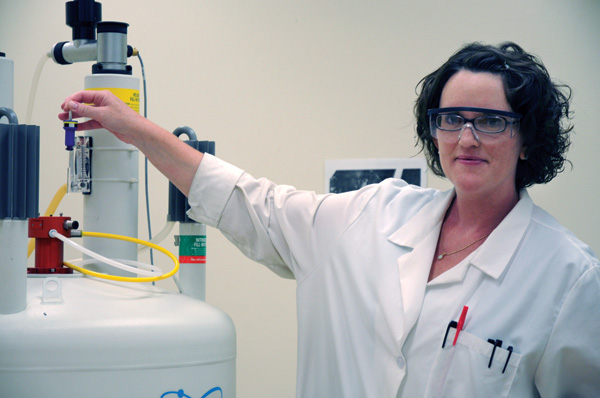Sac State puts stimulus funds to use

Katherine McReynolds, professor, with one of the instruments she bought using the grant money. The machine will help students get a better hands on experience.:
September 3, 2009
Sacramento State recently received more than $5 million in grants from the 2009 stimulus package, including awards from the American Recovery and Reinvestment Act and other awards from the U.S. Department of Education. And eight to 10 grant proposals that may include stimulus funds are still pending. Sac State received $18 million in funding from all sponsored grant and contract awards for the 2008-09 school year.
David Earwicker, assistant vice president of research administration and contract administration at Sac State, spoke about receiving these grants and how they play a very important role in the function of the university as a whole.
“These grants allow the university and faculty to expand research capabilities,” he said. “Grants for research and program building enhance the learning and growth opportunities for both faculty and students of today and tomorrow.”
The Recovery Act awarded six grants to Sac State for the 2009-10 school year.
Sac State chemistry professor Brad Baker was awarded the $260,000 grant by the National Science Foundation. The grant will be used to fund a two-year study he is conducting on reactive chemical emissions in the atmosphere. The funds will purchase instruments that are used to monitor these emissions. It will also be used to support chemistry students who are working on the project.
“Students working in my laboratory over the next couple of years will benefit by gaining research experience that is highly valued by employers in industry and by graduate schools,” Baker said.
Katherine McReynolds, another chemistry professor who received funding, was given two awards totaling in $670,000 for research and lab instruments. The first grant McReynolds received was awarded through the National Institute of Health to assist with summer research for two undergraduate students and one high school student.
“Providing funding for student research allows these students to focus on their chemistry-related work, rather than having to find any other job to help them pay rent and make ends meet,” McReynolds said.
The grant will provide the students with paid full-time work during each summer for two years.
McReynolds was also provided with a second grant through the NSF funds for a second nuclear magnetic resonance spectrometer, an instrument similar to an MRI used by doctors. The spectrometer is widely used in pharmaceutical and biotech industries.
With the number of undergraduate and graduate students increasing in the chemistry department, instruments are not readily available to students. Having the second spectrometer allows more students the opportunity to do hands-on work.
“Our students need hands-on experience in order to be successful in their future careers,” McReynolds said. “Having an original research experience teaches students how to think independently and how to problem solve, two of the most important critical thinking skills one can have.”
Juanita Barrena, professor of biological sciences, was awarded $60,087 by the National Institutes of Health for the Supplement to Sacramento College Coalition for Future Scientists. Jennifer Lundmark, a biological sciences professor, and Deidre Sessoms, teacher education professor, were awarded $75,000 for one year’s efforts for their Learning to Teach curriculum.
The one-year, $210,000 award granted to Alicia Tom of the College of Continuing Education was to help with occupational skills training for people who are unemployed. Tonni Ramirez of the College of Continuing Education said the award money will be funding student enrollment in the eight-week Sustainable Facilities Management certificate program through the Sacramento Employment and Training Agency, which costs $4,000 per student. Ramirez said, “The grants have allowed us to develop and deliver training for unemployed people in a much needed industry in green sustainable building.”
Other programs such as the College Assistance Migrant Program and High School Equivalency Program, HEP, have received stimulus funding through the U.S. Department of Education Office of Migrant Education.
CAMP, a program that helps students from migrant and seasonal farm worker backgrounds transition from high school to college and succeed at Sac State, was allotted $2.11 million for a five-year cycle. The Sac State CAMP was created in 1981 and is one of the largest and is one of the longest running programs in the nation.
HEP also assists migrant farm worker families by offering evening classes for people who did not complete high school to receive their G.E.D. The program was granted $2.3 million for its five-year program.
“We depend on that funding in order to offer this program. This funding is vital,” said Maria Mejorado, HEP director and associate professor of the College of Education in the bilingual multicultural department.
The grant will cover the cost of instructors, materials and the G.E.D. test for every student.
“In an economy where knowledge is the most important commodity a person and a country have to offer, the best jobs will go to the best educated,” President Barack Obama said in a speech about the stimulus at the United States Department of Education. “We’re beginning to offer every single American the best education the world has to offer from the cradle to the classroom, from college to careers.”
The stimulus allocated $4 billion to California by the U.S. Department of Education on April 2, mandating that $3.3 billion be spent on education. The remaining $700 million can be spent at the governor’s discretion. State officials expect the funds to be spent on law enforcement.
Along with funds from the stimulus, California is receiving educational funds under other federal programs such as No Child Left Behind and the Workforce Investment Act.
Brittany Bottini can be reached at [email protected].




























































































































